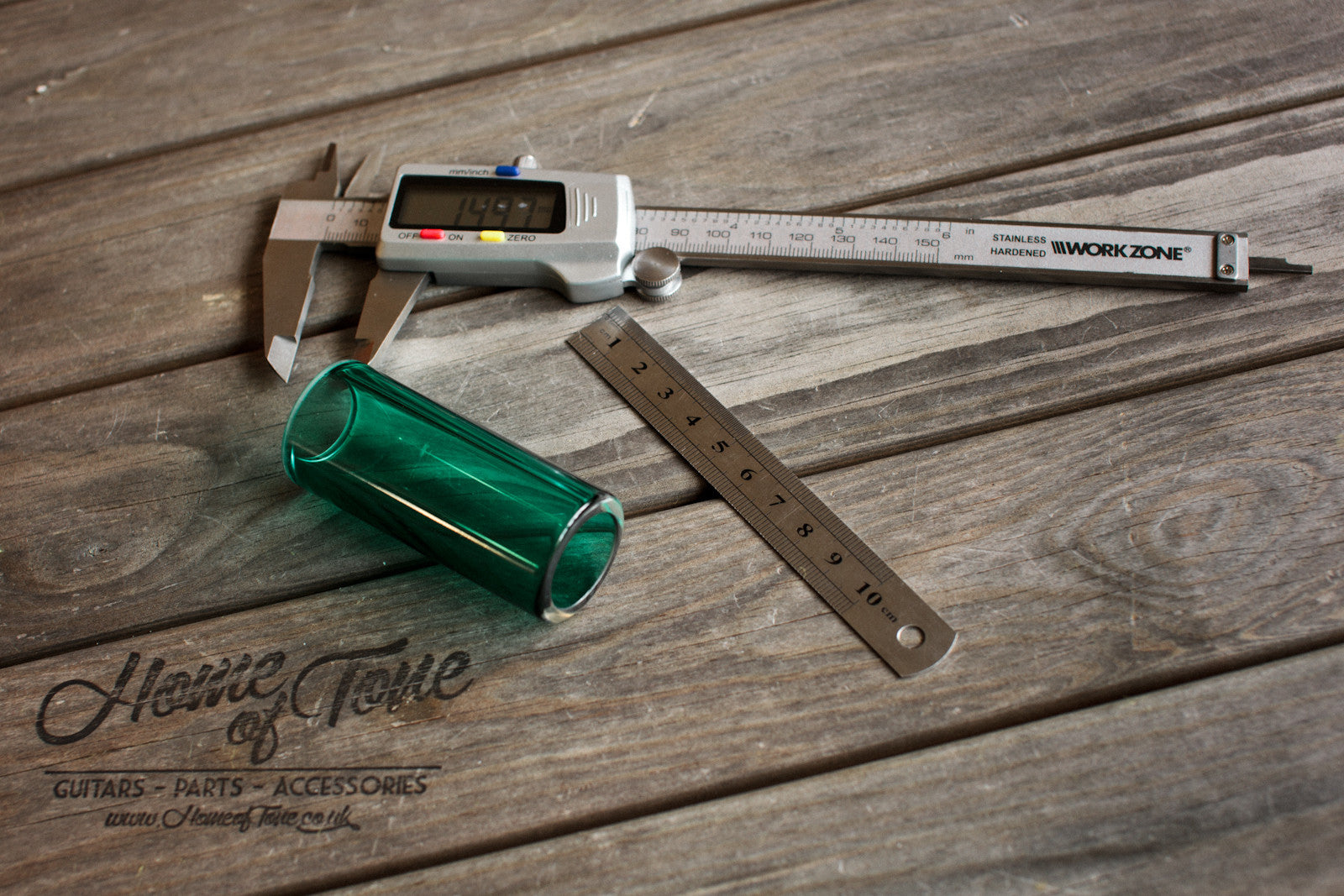One common question I get asked when players are looking to order their Diamond Bottlenecks Slide is, 'How do I make sure I order the right size for my finger?'. I hope to help with that question with this little guide, it's simple don't worry!
With generic music shop metal or pyrex glass slides, most are just sized Small, Medium, Large etc, with a lot of players struggling to find one that's just right from those general sizing's. That's where it becomes very handy that Diamond Bottlenecks do what they do! As sizing options becomes much more refined meaning you're more likely to find the exact size that will see you playing much more comfortably, therefore helping you with your playing!
As I usually stock a wide selection of Diamond Bottlenecks 'Ultimate' slides, I individually list the measurements of each slide to help you find the right one. So hopefully this guide further assists you too!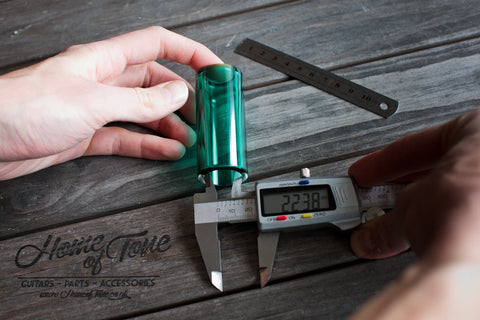
Measuring the Internal Diameter
The main two sizes you'll want to concentrate on in terms of finding the one right for you, is the internal diameter and the length. The internal diameter of the slide is what effects how the slide fits on your finger. So first of all, to measure the slides in store for our listings, we grab the digital veniers, this ensures we're getting a nice accurate measurement, and simply measure it's internal diameter at it's thinnest point. The measurement on the slide product listings will be this measurement, and that's the one you want to take most attention with. Some of the slides do have a tapered internal diameter, and what that means is it may be wider at one end of the slide to the other. This is a nice feature that allows for a more 'snug' fit if perhaps you have slim fingers and find generic slides wobble about at the thinner part of your fingers. So for this, a tapered measurement will be listed. This is simply measured by us by taking measurements from either end of the slide. To see if this is suitable for you, take note of the thinnest of the two measurements :-)
To match this up with what size your chosen slide finger is, grab a small rule, or verniers if you have them (you'll get a more accurate measurement with them but the ruler will still get you the measurement you need) and again, simply measure your desired finger at the widest point. I usually go for the first finger knuckle as 99% of the time that's the widest point. I use my third finger for slide, so here as an example for you. Same rule applies for your pinky, though!
Like so: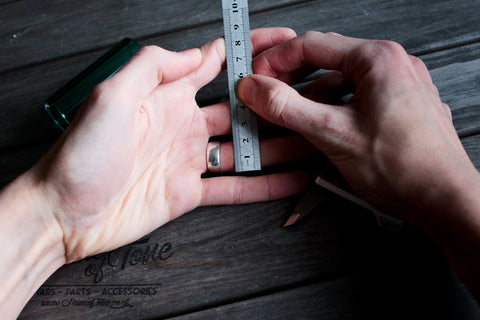
Or with the veneers: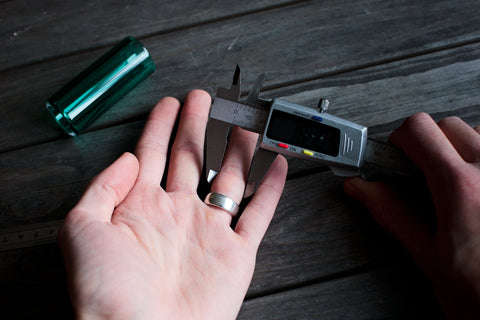
So once you have grabbed that measurement, you pretty much know what sized slide you need to be looking for & ordering. I regularly personally select my stock from Diamond Bottlenecks workshop, so if there isn't currently one in stock that suits your measurements, keep checking back for updated listings.
Length of Slide
So, what are the other measurements we list? Length of the slide is important here, as some players like a shorter slide for single string or note work, whereas most will want a full length to comfortably cover all the strings. We always measure this with Verniers to ensure it's an accurate one for you, and it is simple measure across the length of the slide like so: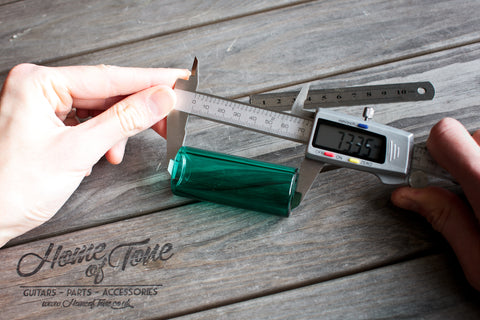
Anything over a 60/65mm length will cover most fretboards, so that's a nice reference point for you. Longer is just down to personal tastes and how the slide feels to use. The longer the slide, usually the heavier it will be too, as there is more Lead Crystal there!
Sidewall Thickness
This measurement, although doesn't affect how the slide fits, will affect how it sounds. The reason why lead crystal slides sound as great as they do, is their weight. In comparison to very lightweight pyrex, lead crystal carries a lovely density to the glass which creates the tone we love, particularly with resonator slide playing for example. So a thicker sidewall, will increase that wonderful thick tone, and the thinner the side wall, will mean it's a little lighter in weight increasing it's agility on your finger. So it's definitely worth considering for your slide playing style. If you like to be lightening quick over the strings, then perhaps look for a thinner sidewall, as it'll be lighter in weight making it more agile. If it's slow and steady for you, then a thicker more toneful sidewall may be best suited. Here's how we measure the sidewall thickness: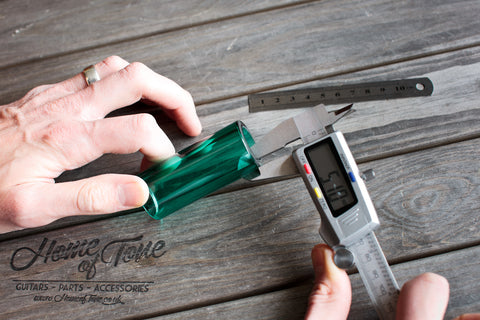
Dome or Open?
You may have noticed some 'Dome' topped slides listed, and thought they were perhaps just for lap steel players. Well, not necessarily. Dome topped slides can give a regular bottleneck player a great feeling slide. Basically due to the dome top, the slide has a bit more weight at the end of your finger meaning accuracy and balance improves. There's no right or wrong on this, it's all personal preference. But if you're a keen player, certainly give it a try, you may be surprised and wonder where it's been all your life! Open top is the most popular choice though, and one I personally use, it is nice to mix it up every once in a while though and I do also still like using a dome top slide for lap slide playing. Lots of versatility here!
Wrap up
Although I've gone into quite a bit of detail here, it is in fact really simple to find the right one for you. We always aim to have a range of sizes in stock to suit most, but like I say, If you don't see the right one listed for you then drop us a message! We'll happily help, as after all, I'm really passionate about slide guitar and love to help like minded players out.
Thanks for checking this guide out and I hope it helps you find the right slide for you.
Here is our Diamond Bottlenecks collection
James
Have you made good use of some of the free resources here? Wired up your guitar or found useful info here along the way? Perhaps you might consider kindly supporting this free resource for guitarists via 'Buy me a coffee'! Thank you so much!

